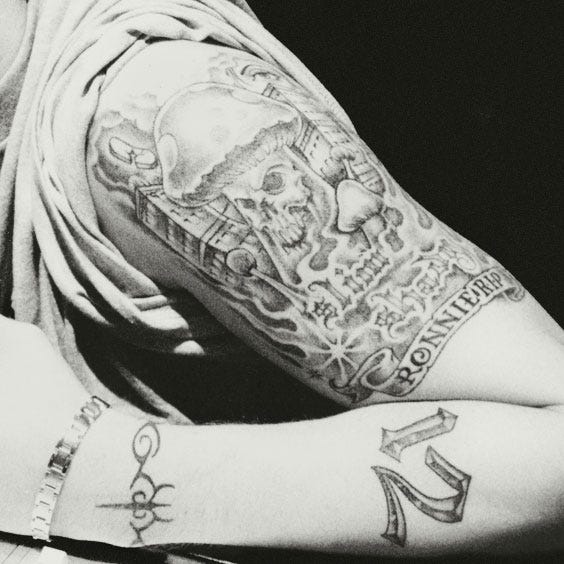Hello my Shady Admirers! Welcome to the second installment of All Things Eminem, where I attempt to give you a better understanding of Marshall Mathers, so you can better appreciate his music.
Last week, I said that we would focus on the history of Eminem in the next post. Thus, I did some major research. I spent around five hours watching documentaries and taking notes which ended up consuming about five pages… single spaced… college ruled. That means I have way too much Eminem history for one post, so I’m going to break it up into multiple posts.
This week will cover most of the trauma in his life caused by men, and next week we will discuss the trauma caused by the women in his life. Both weeks we will be discussing two major themes that are prevalent throughout his life: abandonment and bullies. These two themes have hugely shaped the man that we see today. They are the reason for a meek Marshall Mathers and a psychotic Slim Shady. They create the hard and soft pieces of Eminem. Both pieces of a man worthy of admiration.
I’d like to start out by saying that most of my information comes from these three documentaries found on Youtube: The Story of Eminem - Full Documentary, Eminem: Behind the Lyrics and Eminem Documentary: History Life & Career. I would absolutely recommend watching any and all of these documentaries. They are incredibly insightful and entertaining.
But enough dilly dallying, it’s time to start our journey into the history of Eminem.
Eminem was born on October 17th 1972 and given the name Marshall Bruce Mathers III. He was born in St. Joseph Missouri to Debbie and Bruce Mathers, but only one parent stuck around. Marshall’s father was abusive and cheated on his mother before abandoning them and leaving for California. The young Marshall Mathers wrote his father multiple times, but Bruce never wrote back. Most of the time, the letters came back to Marshall stamped with a return to sender label. Oh, the pain this must have caused such a young boy. He airs his rage toward his father in many songs, but it is especially prevalent in his 2020 song, “Leaving Heaven,” where he asks for a pass to visit hell so he can beat his dad.
Debbie and Marshall would move back and forth between St. Joseph and Detroit many times throughout his childhood. Again, Marshall is learning more and more about abandonment, as he leaves a home and a school every couple of months. The nomadic lifestyle made it really hard for Marshall to build connections with peers which was already difficult when he and Debbie were one of the few white families in the predominantly black neighborhoods they lived in. This resulted in bullying, and the poor kid having very little friends.
Once, a bully, D'Angelo Bailey, beat him so bad it sent him into a ten day coma. When he awoke from his coma, he had brain damage that required him to relearn words and actions like tying his shoes. He studied the dictionary to remember the words he forgot, and it of course ended up taking his vocabulary beyond what is was before. This is why we have the incredible diction that we see in his lyrics today. His ability to take a terrible situation and turn it into something worthwhile absolutely amazes me; he went from brain damaged to a word genius. This is a pattern you can see throughout his life; he turns his pain into something to be proud of. It’s inspiring.
In 1999, Eminem released the song “Brain Damage” on the Slim Shady LP which touches on his run in with D’Angelo Bailey. Part of the song describes him being bullied, however the other half describes himself doing the bullying. It perfectly explains the existence of the alter ego Slim Shady who comes out in songs like “My Name is.” Slim Shady is the bully that Marshall never got to be. That’s why he is dark and irreverent in his songs. Slim Shady was built from the trauma of being bullied. He is a coping mechanism; it is in Slim Shady where Marshall is able to vent his frustrations and heal. This is just another example of Eminem turning around a bad situation; he got bullied, and he created a bully. A bully that became the voice of a generation and brought him fame and fortune. Way to go, Marshall!
I’d like to add a little something about the song “Brain Damage” here. D'Angelo Bailey sued Eminem in 2001 for defamation in the song, but he lost. The judge dismissed the case saying that it was clear that the song was an exaggeration. Part of the judge’s 13 page opinion was actually written in the form of a rap. A rapper, Treach, put the judge’s words with a beat, and created a cool little piece. Check it out!
But back to Marshall’s childhood; I said he had very few friends growing up, which is true, but he did have one really good friend. They were almost like brothers but technically uncle and nephew. Marshall and his uncle Ronnie Polkingharn were born about the same time, and both wanted to be famous musicians. It seemed to be Marshall and Ronnie against the world, until Ronnie died. Eminem cites Ronnie in some of his songs like Cleaning Out My Closet. He also has a tattoo dedicated to Ronnie on his upper left arm. Marshall didn’t go to Ronnie’s funeral and didn’t speak for days after his death. Ronnie was supposedly distraught over a girl and took his life with a shotgun to the head. Suicide. To a teenage Marshall, that was just another form of abandonment.
And 15 years later, abandonment struck again. His older uncle and father figure, Todd Nelson, killed himself with a shotgun to the head; it was the same way Ronnie died. I can’t even imagine the pain this caused Marshall. At this point in his life, he had felt abandoned by his father, his father figure, and his best friend. He captures its effect perfectly in his song, “Rhyme or Reason,” where he basically says that if his dad hadn’t left, he wouldn’t have such a bad attitude or be so mad. It can apply to his uncles leaving too. If they hadn’t taken their lives then he wouldn’t have gotten so angry, so sad and so broken by grief.
It absolutely breaks my heart that Marshall Mathers had to go through all that pain and more. Still, it inspires me to see how he grew from it. He came out stronger every time. His traumas were no match; they could not break him.

That’s it for this post, but be sure to check your inboxes in the next couple of days to see part two of the History of Eminem series. The next post will focus more on the women in Eminem’s life, especially his mother and wife, and the trauma they left him.
Also be sure to leave a comment with your thoughts on this post, and what you’re excited about for next week. If anyone watched the judge’s rap video or listened to any of the songs I referenced, I would especially love to hear your thoughts on the depth of those rhymes!
Thanks for reading, and I’ll see you next time on All Things Eminem!




To be honest, I find it hard to like a person like eminem. I am not trying to disrespect him or your post. I appreciate the history, and I think it helps put things into context.